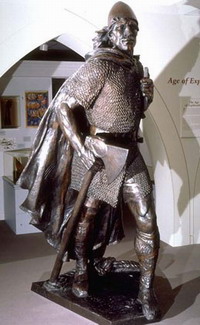Login form
Leif Eriksson

His friends called him Leif the Lucky because he once found a ship filled with treasure. Today, Viking sailor Leif Eriksson is remembered for another lucky adventure. Many people believe he was the first European to reach North America!
We know little about Leif Eriksson’s life. His voyages are described in Icelandic poems called sagas. But these poems were not written down until about ad 1200, some 200 years after Eriksson died. The sagas may contain mistakes or exaggerations.
LIFE IN GREENLAND
The sagas say that Eriksson was born in Iceland about ad 975. When he was about ten years old, he sailed with his family to the island of Greenland. Eriksson’s father, Eric the Red, founded the first Viking settlement there in 985. About 999, Eriksson sailed to Norway and met the king, who was a Christian. Eriksson became a Christian, too.
TALES OF A NEW LAND
Back home in Greenland, Leif bought a ship from a trader named Bjarni Herjólfsson. The trader had an exciting story to tell. When sailing from Iceland to Greenland, he had lost his way in a storm. Through the mist and rain, he caught a glimpse of land!
Eriksson decided to investigate. To the Vikings, land meant riches, plunder, and power. About 1000, Eriksson recruited a crew and set sail from Greenland, heading west. After several days at sea, Eriksson discovered that Herjólfsson had been right. There was land beyond the sea!
A SETTLEMENT CALLED VINLAND
Eriksson and his crew saw rocky shores and then thick forests. Finally, they went ashore at a sheltered spot where luscious berries grew. Scientists aren’t sure exactly where Eriksson landed, but many believe it was the island of Newfoundland. Eriksson named the area Vinland (or Wine Land) because he thought the berries were grapes.
Eriksson probably had no idea he was on the edge of North America, an enormous continent still unknown to Europeans. He spent one winter in Vinland, then sailed home to Greenland.
LEIF THE LUCKY
On his way home, Eriksson found a wrecked trading ship and rescued the crew. As a reward, he was given the ship’s valuable cargo. Now rich and famous, he became the Vikings’ leader in Greenland. He taught the Greenland Vikings his Christian faith. He died in 1020 at the age of 45.
Source: Microsoft ® Encarta

